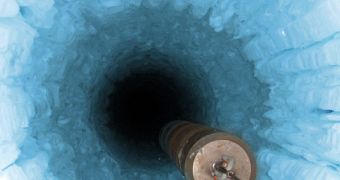A massive project involving the building process of the world's greatest neutrino telescope is currently under development far to the southern pole, in Antarctica. A bold group of experts from the University of Delaware are facing the blistering cold deep underneath the snowy surface in an attempt to have the device named "IceCube" ready by 2011. The telescope is aimed to detect both colossal celestial events and the tiny neutrino particles during their passing through our planet.
A group of technicians, physicists and engineers from the Bartol Research Institute at the University of Delaware work at daily temperature conditions of minus 40 degrees (both Fahrenheit and Celsius). The university is only one of the 33 international institutions involved in the National Science Foundation project coordinated by the University of Wisconsin. The drilling operations are going on continuously during the 24-hour long day of the Antarctic summer season.
"IceCube will provide new information about some of the most violent and far-away astrophysical events in the cosmos," shares Thomas Gaisser, the Martin A. Pomerantz Chaired Professor of Physics and Astronomy from the University of Delaware, one of the lead scientists of the project, quoted by Eurekalert. "All of my career at Bartol Research Institute at the University of Delaware has been to study high-energy particles from space," he reveals. "This experiment we're building fulfills all of my dreams. Besides, it's fun to work here."
When it's ready, the telescope will be a cubic kilometer large and will be comprised of a surface detector array called "IceTop," kilometer-long strings containing 60 optical detectors frozen over a kilometer and a half deep in the ice, as well as a couple of 2,728-liter (600-gallon) "IceTop" reservoirs, housing two optical detectors each. The water, which will turn to bubble and crack free ice during nearly seven weeks, will help detect small flashes caused by neutrino particles passing through. The data will then be transmitted to the IceCube laboratory where the direction the particles came from will be determined.

 14 DAY TRIAL //
14 DAY TRIAL //